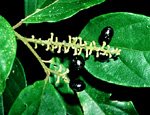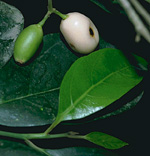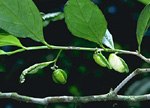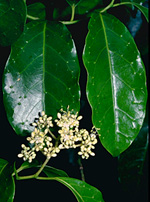 |
This is a family of moderate size, widely distributed throughout the tropics of the world. In Australia, all species are found in rainforests, mostly in northern Queensland but with a few extending south into northern New South Wales.
Characteristic features of the family Icacinaceae in Australia include: - robust trees or (Rhyticaryum) sprawling shrubs with alternate, entire leaves
- flowers small, actinomorphic, bisexual or unisexual and with the males and females borne on separate plants
- sepals and petals usually 5 (rarely 3, 4 or 6), free or fused, the petals inflexed at the apex
- stamens 5, alternating with the petals
- ovary superior, developing into a white to pink or black drupe
Description
Evergreen trees or shrubs. Internal secretions not obvious. Plants glabrous, or with simple, non-glandular, unicellular or uniseriate hairs. Leaves alternate and spiral, or distichous, petiolate. Stipules absent. Lamina simple, symmetric, lanceolate, ovate, elliptic, oblanceolate, obovate or oblong; base cuneate, rounded or rarely attenuate; margins entire, ±flat; venation pinnate, with the midrib conspicuous, and the tertiary venation reticulate; surfaces not punctate; herbaceous. Domatia absent or consisting of pits or pockets in the vein angles. Usually with all the flowers bisexual, or with male and female flowers occurring on separate plants. Inflorescences terminal, axillary or leaf opposed, consisting of panicles, cymes or thyrses. Bracts present. Pollination by insects. Flowers odourless, stalked. Floral disc absent; nectaries absent. Perianth regular, of 2 dissimilar whorls. Calyx segments fused, with (3–) 5 (–6) lobes, imbricate in bud; calyx cup-shaped or bell-shaped, herbaceous. Corolla segments free or fused, with (3–) 5 (–6) petals or lobes, alternating with the calyx segments, valvate in bud; corolla bell-shaped, white or cream, without contrasting markings, membranous; claws present or absent; lobes ±entire or ciliate or fimbriate. Fertile stamens 4 or 5, opposite to the calyx lobes, free or at least partly fused to the corolla, free of the ovary and style, distinct from each other, all ±equal. Anthers dorsifixed or basifixed, not versatile, opening sideways or inwards by longitudinal slits, 2-celled. Ovary superior and sessile. Carpel 1; ovary with 1 locule. Style terminal, single and unbranched, or absent and the stigma ±sessile. Ovules 2 (–3), stalked; placentation apical. Fruit a fleshy, indehiscent drupe; the perianth on the maturing fruit deciduous or dry and persistent. Disseminule macro-surface featureless, or with a lateral appendage (?winged); micro-surface ±smooth, white, orange, red, pink, green or black, without contrasting markings, or rarely conspicuously patterned, glossy. Seeds 1 per fruit. Aril absent. Cotyledons 2. Embryo straight or curved.
(Note: this description has been generated from the coded data compiled for the key. Any errors in the key data will be reflected in the descriptions.)
A treatment of the family Icacinaceae has been published in:
Flora of Australia 22: 204-211.
Australian genera of Icacinaceae (as recognised for the Flora of Australia)
Apodytes
Citronella
Gomphandra
Irvingbaileya
Pennantia
Ryticarium
Stemonurus

|
  |

Citronella smythii (fruits)
Photo: G.Sankowski © Zodiac Publications

Gomphandra australiana (fruits)
Photo: H.Nicholson © H. & N. Nicholson

Irvingbaileya australis (fruits)
Photo: H.Nicholson © H. & N. Nicholson

Pennantia cunninghamii (flowers)
Photo: G.Leiper © G.Leiper
|
 |
|